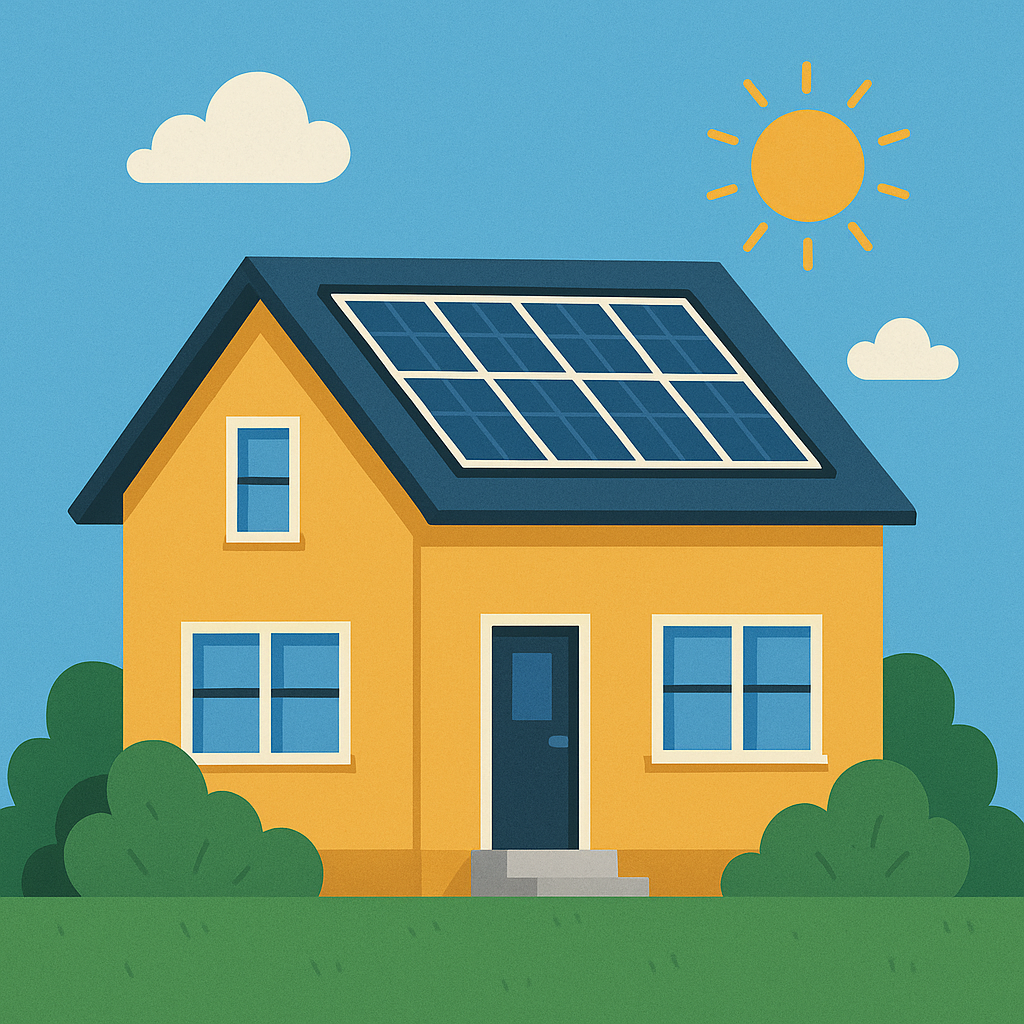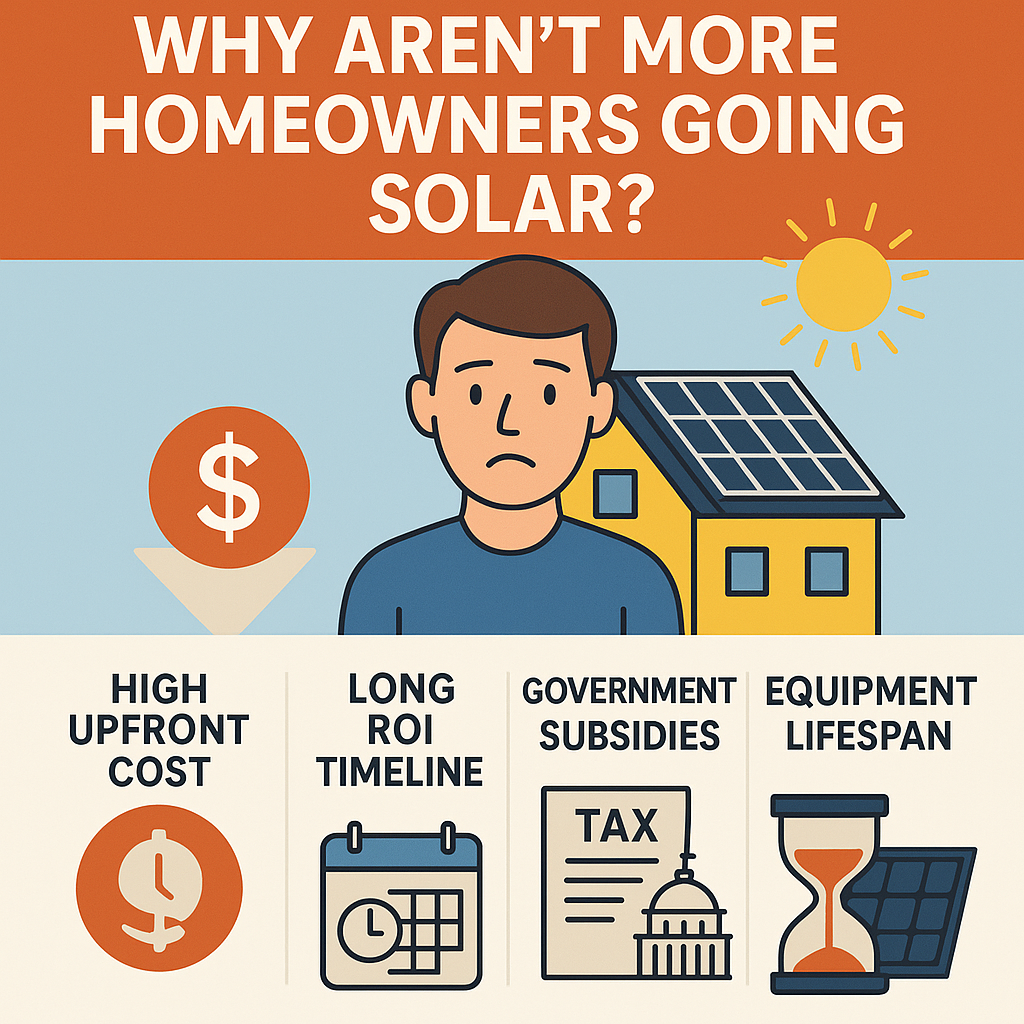When solar panels first hit the residential market, they were heralded as a revolution. Clean, renewable, and supposedly economical energy—who wouldn’t want that on their rooftop? Yet, here we are in 2025, and the truth is sobering: residential solar adoption in the United States still hovers under 5% of eligible single-family homes. In sunny states like Texas, California, and Arizona, you’d expect rooftops to be gleaming with panels—but they’re not.
Why?
Despite federal tax credits, state rebates, and endless marketing from solar companies, most homeowners still see solar as a luxury investment rather than a smart utility choice. And in many ways, they’re right. The math doesn’t add up for the average homeowner—not yet.
Let’s explore why participation is still so low, and how we can flip the script on solar economics with near zero-down, ROI-tied payment models.
The Elephant on the Roof: High Upfront Costs
The biggest barrier to entry for residential solar remains the upfront cost. Depending on system size and region, a typical home solar installation can cost $15,000 to $30,000 before incentives—and still $10,000 to $20,000 even after tax credits.
Sure, there’s a 30% federal solar tax credit, but not every homeowner can take full advantage of it. If you don’t have a large enough tax liability, much of that credit is lost. And for lower-income families who rent or live paycheck to paycheck, this credit is about as useful as a solar panel on a rainy day.
Financing options exist, but they often come with catches—high interest rates, balloon payments, or long-term contracts with early termination penalties. For many, it feels like trading one utility bill for another, with a hefty gamble on future savings.
The Long Game: Return on Investment That Outlasts the Equipment
Let’s say you do take the plunge and invest $20,000 in a solar setup. When do you break even?
Most estimates suggest it takes 8 to 15 years to break even on residential solar, depending on your electricity rate, solar exposure, and utility policies like net metering.
But here’s the kicker: the average lifespan of a solar panel system is 20–25 years, and inverters often need replacement in 10–15 years. That means your system might just break even before it starts needing costly repairs—or worse, before it stops working efficiently altogether.
If you sell your house before that break-even point? You may not recoup your investment, even if your home sells for a bit more. Appraisers and buyers often don’t value solar systems at their full cost unless they’re paid off and performing well.
Government Incentives: A Band-Aid, Not a Bridge
Tax credits are helpful, but they’re not a full solution. They mostly benefit homeowners who already have disposable income, stable employment, and enough tax liability to claim a significant deduction. For everyone else, the credit is delayed, partial, or irrelevant.
State-level incentives are inconsistent, confusing, and often underfunded. Some utilities offer rebates or net metering, but others push back, cutting credits or slapping solar users with extra fees.
And let’s be honest—navigating these incentives takes time, research, and sometimes professional help. The result? Frustrated homeowners who give up before they even start.
Leasing and PPA Models: Better, but Still Flawed
To lower barriers, some companies offer solar leases or power purchase agreements (PPAs), where homeowners pay little or nothing upfront. The solar provider installs and owns the system, and the homeowner either pays a fixed lease or buys the power generated at a rate (usually lower than grid prices).
It’s a smart concept—but not without problems:
- No ownership: You don’t own the system or get the tax credits.
- Locked-in contracts: Terms can last 20–25 years with costly exit fees.
- Home sales complications: Buyers may not want to assume your lease or PPA.
- Savings vary: You may only save 10–20% on your bill—not enough to justify the hassle.
The Core Problem: Misaligned Incentives
Here’s the real issue: the current solar business model is built around selling hardware, not saving homeowners money. Solar companies make their money upfront—through sales, installations, and sometimes financing deals.
Once the panels are on your roof, your long-term savings are your problem. There’s no accountability or performance guarantee that you’ll actually save what you were promised.
In most industries, products must perform to generate long-term value. But in solar, the incentives end at installation.

A Smarter Solution: Zero-Down, Savings-Tied Solar Models
So how do we fix this?
We need solar models that shift the risk from the homeowner to the provider. In other words, companies should only get paid when the homeowner actually sees savings. This is possible—and already emerging in some pilot programs and startups.
Here’s what that model could look like:
✅ Near Zero Down Payment
Homeowners pay little or nothing upfront. Installation is free or rolled into future performance-based payments.
✅ Savings-Tied Monthly Payments
Monthly payments are based on actual energy savings, not projections. If your system saves you $100 per month, maybe you pay $70 and keep $30. If savings are less, you pay less. No savings? No payment.
✅ Built-in Maintenance and Monitoring
The provider is responsible for system health and performance—because they only get paid if it works. This aligns incentives and builds trust.
✅ Portable or Transferable Agreements
Contracts should transfer easily to new buyers or be portable to a new home, removing friction when selling your property.
✅ Performance Guarantees
Systems should come with written guarantees of minimum production—so you’re not left hoping the sun shines just right.
Why This Works
This model changes everything.
It makes solar:
- Accessible to middle- and lower-income families
- Low-risk and low-hassle
- Performance-driven and accountable
- Scalable and equitable
It also mirrors how many Americans already pay for things: subscription models based on actual use or benefit, like streaming services, data plans, or even gym memberships.
Most importantly, it brings solar back to its roots—not as a luxury product, but as a practical energy alternative that competes head-to-head with the grid.
What Needs to Happen Next
For this smarter model to scale, a few things must fall into place:
- New Solar Financing Companies Must Lead the Way
We need entrepreneurs and investors to build solar companies that prioritize performance over quick sales. These models are emerging—especially in Europe—but need broader U.S. adoption. - Policy Support for Performance-Based Models
Incentives should reward delivered kilowatt-hours, not installed capacity. States and utilities should support outcome-based solar programs, not just installations. - Utility Cooperation, Not Resistance
Some utilities resist rooftop solar because it reduces their revenue. That mindset must change. Utilities should be incentivized to help homeowners reduce peak demand and decentralize energy generation. - Public Awareness and Education
Many homeowners still believe solar is too complicated or unaffordable. We need clear, simple messaging that emphasizes real-world benefits, minimal risk, and proven savings.
Conclusion: It’s Time for Solar 2.0
Ken, the dream of a solar-powered nation isn’t dead—it’s just stuck. And it’s not stuck because of bad intentions or lack of technology. It’s stuck because the economic model is broken for the average homeowner.
Solar can’t be just for the wealthy or the idealists. It needs to be for everyone—especially the middle-class Americans footing ever-growing electric bills each summer.
The solution isn’t just better tax credits or fancier panels—it’s better alignment. Homeowners should only pay when they save. It’s fair, it’s scalable, and it’s long overdue.
The sun is already shining. Now it’s time for solar companies to stop selling sunlight—and start selling savings.
FAQ
Q: Isn’t solar cheaper now than it used to be?
Yes, panel costs have dropped dramatically over the past decade. But soft costs—like installation, labor, permitting, and financing—still keep total system prices high for homeowners.
Q: What happens to my roof during installation?
Most reputable installers ensure that solar mounts don’t damage your roof. Many also include roof inspections and warranties. But always verify before signing a contract.
Q: Can I get solar if I rent my home?
Unfortunately, not usually. Most solar installations require property ownership. However, community solar programs allow renters to benefit by “buying in” to shared solar farms.
About the Author

Mister San-Marcos is a resident of the great state of Texas and considers himself a strategic thinker on all topics. Politically, you’ll find him to be more right-leaning, but not too far. He has lived a wonderful life and a successful career and is now focusing his time on sharing his thoughts and recommendations to the world.



